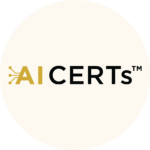
AI CERTS
6 months ago
AI UX Design Training: Shape the Future of UX with AI
In a world where technology evolves faster than ever, AI User Experience (UX) Design stands out as a field pushing the boundaries of how we interact with digital products. From chatbots that feel like real conversations to personalized recommendations that cater to our unique tastes, AI is transforming user experiences. However, creating these dynamic experiences requires a new set of skills that AI UX Design training provides.

In this guide, we’ll walk you through everything you need about AI UX Design Training, why it’s becoming essential for designers, what you’ll learn, and how to get started on a career path shaping tech’s future.
Why AI UX Design Matters Now
AI is no longer the stuff of sci-fi movies; it’s part of our everyday lives. We interact with AI whenever we search for a song, receive a personalized product suggestion, or use a virtual assistant. But the secret sauce behind these seamless experiences is AI User Experience Design, a unique blend of AI and UX principles that enables smarter, more intuitive interfaces.
Today, brands want to offer users more than just attractive visuals; they want experiences that adapt to their preferences, anticipate their needs, and keep improving over time. As a result, the demand for UX designers with AI expertise is skyrocketing, and the best way to meet this demand is through AI UX Design training. It’s a game-changer, and it’s opening doors for those ready to embrace this new frontier.
What Exactly is AI User Experience Design Training?
AI UX Design training programs cover the essential skills and tools that help designers harness the power of AI to enhance digital experiences. Unlike traditional UX training, which focuses primarily on interface design, AI UX training dives into AI fundamentals like machine learning, data analytics, and even ethics.
Imagine creating an app that learns from each user interaction to make itself more helpful and personalized over time. Or designing a chatbot that picks up on user emotions and responds empathetically. These are the types of skills that AI UX Design training offers, empowering designers to create experiences that go beyond static interactions.
Key Topics Covered in AI UX Design
- AI Basics for UX Designers: Even if you’re not a coder, you’ll gain a working knowledge of AI concepts like machine learning, so you understand what’s happening behind the scenes.
- Data-Driven Design: Learn how to use data to inform design decisions, creating experiences that align with user behavior and needs.
- Ethics in AI: An essential topic, ethics ensures that the AI-enhanced experiences you create are fair, unbiased, and respect user privacy.
By the end of this training, designers emerge with a skill set that combines technical knowledge with creativity, allowing them to craft smarter, more adaptive digital products.
The Skills You’ll Develop Through AI UX Design
AI UX design training is more than just learning a few new tools; it’s about acquiring a mindset that focuses on adaptivity, empathy, and precision. Here’s a peek at the types of skills you’ll gain:
- Problem-Solving with AI Insights: You’ll learn how to use AI to tackle complex UX challenges, like optimizing layouts based on user interactions or recommending content that aligns with users’ preferences.
- Personalization Mastery: By diving into predictive modeling, you’ll understand how to create truly personalized experiences that feel almost magical.
- Technical Know-How: From AI-powered design tools to data visualization, you’ll get hands-on with the tech that’s shaping tomorrow’s UX.
These skills make you not only a better designer but also a valuable team member in tech-driven environments where user experience is key to success.
Top AI UX Design Certifications to Kickstart Your Career
Earning a certification in AI UX Design not only enhances your skill set but also signals to employers that you’re equipped with the latest tools and methodologies. Here are some reputable certifications offered by leading organizations and universities:
1. AI+ UXDesign Certification by AI CERTs
The AI+ UXDesign Certification from AI CERTs covers the essentials of AI in UX, blending technical foundations with hands-on design principles. This course is ideal for those seeking a deep dive into AI-driven UX design.
- Duration: Self-paced
- Highlights: AI ethics, predictive design, and data-informed UX
- Ideal for: UX designers looking to specialize in AI-driven interfaces
- Learn More

2. Google UX Design Professional Certificate (with AI Modules)
Available on Coursera, Google’s UX Design Professional Certificate includes modules on AI integration, making it a great foundation for understanding data-driven, adaptive design.
- Duration: Approximately 6 months
- Highlights: Design thinking, user-centered AI, data analysis
- Ideal for: Beginners seeking a comprehensive UX foundation with AI insights
- Learn More
3. Machine Learning and Artificial Intelligence for UX Design by LinkedIn Learning
LinkedIn Learning’s course, Machine Learning and Artificial Intelligence for UX Design introduces key concepts like AI-powered user research and predictive modeling. Perfect for a quick, focused AI UX education.
- Duration: Self-paced
- Highlights: Predictive design, data-driven insights, and rapid prototyping
- Ideal for: UX designers seeking practical, AI-focused skills
- Learn More
4. User Experience (UX) Design Certificate with AI Specialization by Stanford Continuing Studies
Stanford’s User Experience (UX) Design Certificate includes an optional AI specialization, emphasizing real-world AI UX design applications.
- Duration: Varies
- Highlights: Data-driven UX, AI ethics, and adaptive design
- Ideal for: Designers aiming to add AI expertise to an existing UX foundation
- Learn More
5. Advanced UX Design for AI by Interaction Design Foundation (IDF)
The Advanced UX Design for AI course by IDF teaches AI-based personalization, adaptive interfaces, and data interpretation, making it valuable for experienced UX professionals.
- Duration: 8-10 weeks
- Highlights: AI-driven personalization, adaptive interface design, data interpretation
- Ideal for: Experienced UX designers seeking specialization in AI UX
- Learn More
Tools of the Trade: AI UX Design Software You’ll Use in Training
Designing with AI requires more than Photoshop and Illustrator. In AI UX Design training, you’ll be introduced to AI-powered tools that make it possible to analyze data, create predictive models, and automate repetitive tasks.
- Adobe XD with AI Plugins: This tool integrates AI to suggest layouts and elements based on user behavior patterns.
- Sketch with Predictive Design Features: Sketch’s AI plugins allow for faster prototyping by automating common tasks and predicting layout changes.
- Figma with Data-Driven Insights: Figma offers data analysis tools that help UX designers make decisions based on real-time user data.
With these tools, you’ll not only save time but also gain insights into how users interact with your designs, allowing you to refine them for better experiences.
Real-World Impact of AI UX Design

AI UX design isn’t just a trend; it’s a transformative approach that’s reshaping industries. Here are some examples of how AI-driven UX is being used to solve real-world problems:
- E-commerce Personalization: AI helps online retailers recommend products based on past user behavior, boosting engagement and sales.
- Healthcare: In healthcare apps, AI UX designs enable more accurate symptom-checking and personalized health advice.
- Finance: In banking, AI UX allows for intuitive apps that guide users through complex processes, making financial management easier.
These applications show just how impactful AI UX design can be in improving everyday experiences, from shopping to healthcare.
Challenges and How Training Helps Overcome Them
Every innovation comes with challenges, and AI UX design is no different. From addressing AI bias to ensuring data privacy, designers face new ethical and technical issues. Here’s how training prepares you:
- Understanding and Preventing Bias: AI UX Design training often includes ethics modules that teach you how to design AI interactions that are fair and inclusive.
- Data Handling: Handling user data comes with responsibility. Training helps you understand the security protocols and privacy laws necessary to protect user information.
- Balancing Automation with Control: AI UX isn’t about replacing human input but enhancing it. Training guides you on when to let AI take the lead and when to keep users in control.
By preparing for these challenges, you’ll be equipped to create experiences that are not only innovative but also trustworthy.
What the Future Holds for AI UX Design
As AI technology advances, we’re likely to see even more sophisticated applications in UX. Hyper-personalized interfaces, voice-activated designs, and AR/VR experiences are just the beginning. In the future, designers who know how to leverage AI will be able to create environments that respond dynamically to each user’s unique needs and preferences.
Imagine a fitness app that adapts workouts based on biometric data or an educational platform that customizes learning paths for each student. These are the types of experiences AI UX design can make possible.
Getting Started: How to Begin Your Journey in AI UX Design
Starting in AI UX design might seem intimidating, but it’s easier than you think if you break it down into steps:
- Choose a Training Program: Based on your schedule and goals, select a program that offers the skills you need.
- Practice on Real Projects: The best way to learn is by doing. Try building a simple app or website with AI-powered features to see how it changes user interactions.
- Build a Portfolio: Showcase your projects and skills by creating a portfolio. Include projects that highlight AI-driven designs, so potential employers can see your expertise.
- Stay Updated: AI UX design is an ever-evolving field. Keep up with new tools, trends, and case studies to remain competitive.
By following these steps, you’ll be on the right path to becoming a leader in AI-powered UX design.
Conclusion
AI User Experience Design is more than a career path; it’s a way to reimagine how people interact with technology. As companies invest in smarter, more personalized experiences, those trained in AI UX design will lead the way, creating intuitive products that truly resonate with users. If you’re ready to make your mark in this dynamic field, now is the perfect time to start your journey in AI UX Design training.
"Ready to elevate your career with cutting-edge AI certifications in UX Design? Contact us today to start your journey!"
Here are our other articles you might be interested :